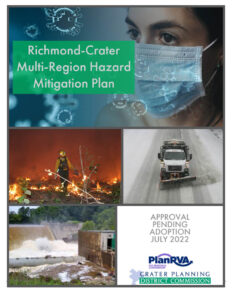Local jurisdictions to adopt new hazard mitigation plan

Earlier this summer, we shared a few new updates made to the Richmond-Crater Multi-Regional Hazard Mitigation Plan as part of FEMA’s requirement to reassess and update it every five years. We’re
thrilled to share that the new plan for 2022 was reviewed and approved by FEMA and then sent to local jurisdictions for adoption. So far, the new plan was adopted by the Prince George Board of Supervisors, Town of Jarratt Town Council and Dinwiddie County and is being reviewed by the 19 other localities in the Richmond and Crater regions.
Local adoption of the plan is required by FEMA to be eligible for federal disaster relief funds. To increase awareness about the region’s hazard mitigation plan and ensure more resilience projects qualified for funding, team members at PlanRVA invited individuals from multiple departments and agencies across the region as well as the public to participate.
One of the goals during the plan update process for 2022 was to strengthen and develop partnerships for mitigating and reducing hazard impacts.
Taking an integrated approach
Emergency managers have been a key stakeholder of hazard mitigation planning and have historically been a main driver of managing the Richmond-Crater Multi-Regional Hazard Mitigation Plan. But with an increase in hazardous events, overlap in funding needs for hazard relief and opportunities to fund projects across multiple departments, it became very apparent there was a need to better integrate planning process.
“We set it upon ourselves to ensure that all stakeholders and departments were heard in this process. We wanted it to be meaningful for multiple departments, “said Sarah Stewart, Planning Manager at PlanRVA. “Everyone was welcome to participate at whatever level they were capable of.”
While most localities had emergency managers remain the main points of contact, many localities had staff in other disciplines engaged throughout the process, including planning, environment, public utilities, and parks and recreation. There were also Tribal nation staff and researchers at Virginia academic institutions involved in the planning process.
“It was great to hear a diversity of voices during the process that may not otherwise have been there,” said Stewart. “Thanks to significant community input, our hazard mitigation plan builds on local knowledge and expertise to give leaders the tools to take action and prepare before a disaster occurs to reduce its impact.”
Benefits of getting more voices involved
The hazard mitigation plan is a steppingstone to FEMA funding and can be a pre-requisite for other funding streams. A key reason it is important to participate and critically consider what is included in a hazard mitigation plan is that inclusion in the plan as a mitigation action gives a project a competitive advantage when being considered for many grant programs.
A great example of multiple departments coming together as part of the collaborative process is the addition of the Chesterfield County Mitigation Action 10 to the plan. The action is an acquisition program for the Chesterfield Park system that incorporates hazard mitigation potential in decision making for acquiring new park land and open space easements.
“I had conversations with staff of the County’s Parks and Recreation Department, Chesterfield’s Floodplain Manager and others,” said Stewart. “I'm inclined to say that if we had just involved emergency managers
in the process, you would not see as many mitigation actions like this one. Action 10 is in many ways dependent upon the parks department running it forward.”
Building networks and breaking down silos is one of the best ways to improve the ability of a locality and a region to be resilient in the face of hazards. Involving more voices this year has set PlanRVA and other stakeholders up for success for future processes when updating the regional hazard mitigation plan.
Subscribe to The Better Together Connector
Sign up to receive The Better Together Connector, a quarterly e-newsletter designed to highlight the latest efforts, successes and a look ahead from PlanRVA, the Central Virginia Transportation Authority, the Richmond Transportation Planning Organization, and the Emergency Management Alliance of Central Virginia.


